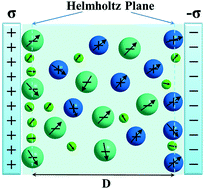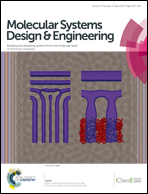Water dissolution in ionic liquids between charged surfaces: effects of electric polarization and electrostatic correlation†
Abstract
Water dissolved in ionic liquids garners particular attention in electrochemistry, as represented by the case where water molecules cannot be completely removed from ionic liquids. Nevertheless, the effects of such polarizable polar molecules on the energy efficiency of electrochemical devices remain elusive. Thus, we highlight the effects of the spatially varying dielectric response of water and ionic liquid near charged plates using a coarse-grained mean-field theory that simultaneously accounts for both the permanent and induced dipole moments of the species and the strong electrostatic correlation. We show that water can be adsorbed onto electrodes primarily because of the dielectric contrast between the species. Our results predict that linear-dielectric theory is inadequate to account for the correlation between the capacitance and dielectric contrast, which may be fitted by exponential functions. Electronic polarizability can enhance the capacitance. A higher-dielectric component preferentially solvates electrodes, but this effect competes with that of the charge screening. Our theory shows that strong electrostatic correlation causes the dipolar cation and anion to form alternating layers, which in turn yields substantial increases in the capacitance. Our results compare favorably with previous molecular dynamics simulations.



 Please wait while we load your content...
Please wait while we load your content...